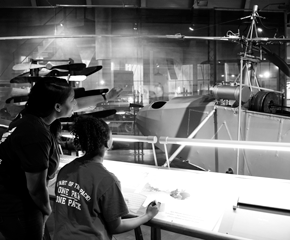"Long Live" and Prosper: Fandom in Pop Culture
Have you ever decked yourself out in head-to-toe colors of your favorite sports team? Discussed theories about your favorite TV show? Celebrated a fictional holiday like Festivus, wished someone “May the Fourth be with you,” or worn pink on Wednesdays? If so, then you’ve participated in fandom.

On May 4th of each year, Star Wars fans celebrate Star Wars Day. Once a grassroots, fan-led celebration, it has been embraced by Lucasfilm and Disney and bled over into the popular consciousness. / THF95553
The idea of fandom — a group of fans of something or someone, particularly enthusiastic ones — can trace its roots back to the literature of the 1800s and early 1900s. In 1894, literary scholar and critic George Saintsbury coined the term “Janeites” to refer to the most intense devotees of the work of Jane Austen. In 1903, after receiving numerous letters from the character’s devoted fanbase (and after 20,000 readers cancelled their subscriptions to The Strand, in which his stories were published), Sir Arthur Conan Doyle brought Sherlock Holmes back to life, eight years after killing the character off in hopes of moving on to other projects. Doyle’s “resurrection” of Sherlock Holmes is perhaps one of the earliest examples of fandom shaping the work that it so adores.

Sherlock Holmes’s popularity has lasted well beyond his own “lifetime.” He has been portrayed in film and television over 250 times, and is often treated as a real historic figure, despite his fictional nature. / THF722711
In the late 1920s and early 1930s, fandom communities began to coalesce around the stories published by Hugo Gernsback in Amazing Stories, the first science fiction magazine. Gernsback published the letters and addresses of fans who sent in mail to the magazine, allowing fans to begin writing to each other, too, meeting up whenever possible. In 1934, Gernsback created the Science Fiction League, a correspondence club for fans of the genre. The Philadelphia Science Fiction Conference was held in 1935, arguably the first of what would become known as “fan cons,” or fan conventions.

Science fiction remained a fertile ground for fandom. In the 1970s, fans of shows like Star Trek began to focus on the relationships between characters, producing creative works like fan fiction and ”fan vids” that explored character dynamics beyond what was presented in the original media. / THF362462
The bar for fandom in music was set by Beatlemania. From 1963 to 1966, young, passionate, female fans of The Beatles created a subculture unlike any the world had previously seen. Originally, Beatlemania was confined to Britain; the phenomenon went international, though, with the band’s appearance on The Ed Sullivan Show in 1964. Everywhere the Beatles went, they were followed by screaming fans, captivated by the band’s memorable hooks, accessible themes, and on-stage charisma. This fervor would last until the group’s last stadium concert in 1966. Beatlemania created the template that later boy bands would seek to imitate, and screaming female fans became a staple of boy band concerts into the 21st century.

At the peak of Beatlemania, there was a plethora of Beatles memorabilia available on the market – whether you wanted to represent the band as a whole, or a particular favorite Beatle. / THF92312
Fandom can be more than just a one-way street. The relationship between Taylor Swift and her fans — dubbed “Swifties” — has changed the face of fandom, both inside and outside of the music industry. Throughout her career, Swift has interacted with her fans on social media, teased upcoming projects with “Easter eggs” for them to decode, and at one point even invited them to “Secret Sessions” — exclusive, invitation-only listening parties where select fans, handpicked by Swift, were the first to hear her soon-to-be-released albums. In return, Swift’s fans have catapulted her to incredible heights of success. The relationship between artist and fandom, however, is not without concern, as Swift herself has alluded to the parasocial extent to which some fans have taken the relationship.

In 2024, Time magazine named Taylor Swift their Person of the Year. The level of fandom surrounding her that year was such that she became what writer Sam Lansky called “the main character of the world." / THF722029
History shows that fandoms have the power to shape popular culture. But why do people join fandoms? The same themes — the feeling of acceptance, understanding — crop up in many discussions around the question. So, too, does the topic of escapism — using another world, or even another person, as a distraction from the stress of one’s own life. It is part of human nature to seek inclusion and comfort, to feel as if we belong as part of a group, that we have found a safe space. Perhaps this, then, is the role that fandoms fill, and why they remain a recurring part of our stories.
Rachel Yerke-Osgood is an Associate Curator at The Henry Ford.


Facebook Comments